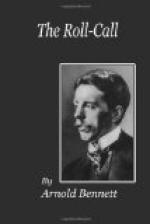Then, as the line curved, came the view of the city beneath its delicate canopy of mist. The city was built on escarpments, on ridges, on hills, and sagged here and there into great hollows. The serrated silhouette of it wrote romance upon the sky, and the contours of the naked earth beyond lost themselves grandly in the mystery of the north. The jutting custom-house was a fine piece of architecture. From the eighteen-forties it challenged grimly the modern architect. On his hasty first visit to the city George had noticed little save that custom-house. He had seen a slatternly provincial town, large and picturesque certainly, but with small sense of form or dignity. He had decided that his town hall would stand quite unique in the town. But soon the city had imposed itself upon him and taught him the rudiments of humility. It contained an immense quantity of interesting architecture of various periods, which could not be appreciated at a glance. It was a hoary place. It went back to the Romans and further. Its fragmentary walls had survived through seven centuries, its cathedral through six, its chief churches through five. It had the most perfect Norman keep within two hundred miles. It had ancient halls, mansions, towers, markets, and jail. And to these the Victorian-Edwardian age had added museums, law courts, theatres; such astonishing modernities as swimming-baths, power-houses, joint-stock banks, lending libraries, and art schools; and whole monumental streets and squares from the designs of a native architect without whose respectable name no history of British architecture could be called complete. George’s town hall was the largest building in the city; but it did not dominate the city nor dwarf it; the city easily digested it. Arriving in the city by train the traveller, if he knew where to look, could just distinguish a bit of the town hall tower, amid masses of granite and brick: which glimpse symbolized the relation between the city and the town hall and had its due effect on the Midland conceit of George.
But what impressed George more than the stout, physical aspects of the city was the sense of its huge, adventurous, corporate life, continuous from century to century. It had known terrible battles, obstinate sieges, famines, cholera, a general conflagration, and, in the twentieth century, strikes that possibly were worse than pestilence. It had fiercely survived them all. It was a city passionate and highly vitalized. George had soon begun to be familiar with its organic existence from the inside. The amazing delays in the construction of the town hall were characteristic of the city, originating as they did not from sloth or indecision but from the obduracy of the human will. At the start a sensational municipal election had put the whole project on the shelf for two years, and George had received a compensatory one per cent on the estimated cost according to contract, and had abandoned his hope.




